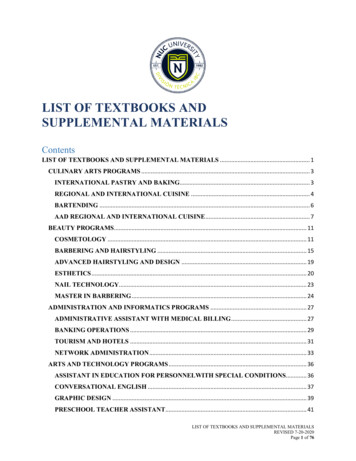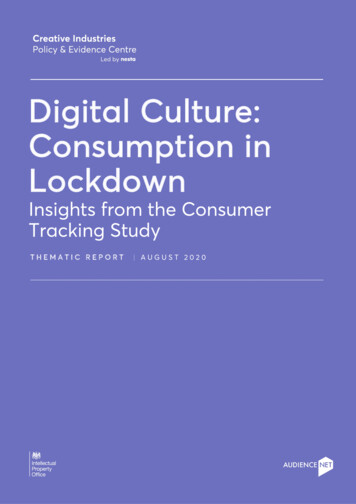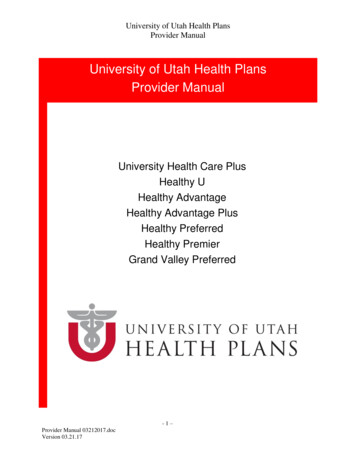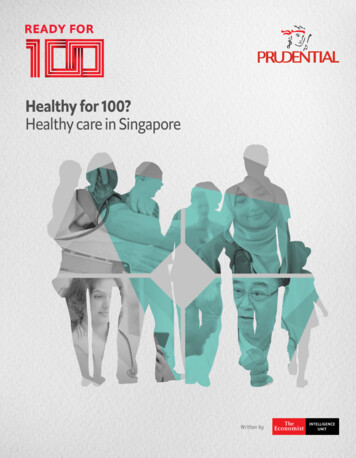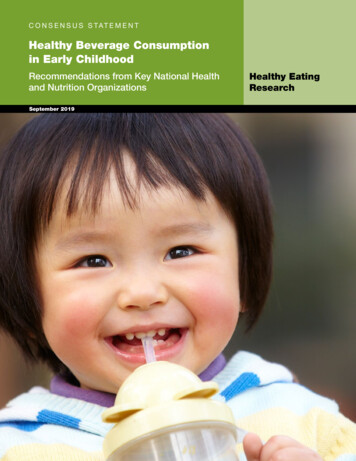
Transcription
C O N S E N S U S S TAT E M E N THealthy Beverage Consumptionin Early ChildhoodRecommendations from Key National Healthand Nutrition OrganizationsSeptember 2019Healthy EatingResearch
C O N S E N S U S S TAT E M E N THealthy Eating ResearchHealthy Beverage Consumptionin Early ChildhoodRecommendations from Key National Healthand Nutrition OrganizationsSeptember 2019INTRODUCTIONEstablishing healthy dietary patterns in early childhood (0 to 5years) is important to help prevent future diet-related chronicdiseases, as well as to support optimal physical and cognitivegrowth and development and overall health.1-4 Healthybeverage intake is critical in early childhood as beverages canmake a significant contribution to dietary intake during thisperiod,5 and thus may serve as important sources of essentialnutrients. However, many beverages also contain added sugarsand saturated fats, which can be harmful when consumed inexcess.6 Overconsumption of unhealthy beverages along withinadequate consumption of healthy beverages in early childhoodcan contribute to risk of diet-related chronic diseases, such asobesity, type 2 diabetes, or dental caries.7 This makes beverages acritical target for improving the health and well-being of infantsand young children.Despite the importance of healthy beverages in early childhood,many young children’s beverage intakes diverge from evidencebased recommendations. For example, many infants consumemilk and 100% juice before their first birthday, which canincrease their risk for nutrient deficiencies, such as anemia.6Among 2 to 5-year-olds, close to half (44%) consume a sugarsweetened beverage (SSB) daily,8 and the prevalence of SSBconsumption increases throughout childhood.5 There are alsosignificant differences in beverage intake by race/ethnicity andincome groups in early childhood that need to be addressed.9,10BACKGROUNDMany authoritative bodies have issued guidance andrecommendations for healthy beverage intake,5,11,12 butimportant gaps exist as these recommendations have not beencomprehensive in the age groups covered or in the types ofbeverages discussed. There also are inconsistencies in certainaspects of existing recommendations, such as suggestedconsumption amounts or recommended ages for introduction,potentially contributing to misunderstanding among health careproviders, parents, and caregivers.Given the importance of beverage consumption in earlychildhood and the need for comprehensive and consistentevidence-based recommendations, Healthy Eating Research(HER), a national program of the Robert Wood JohnsonFoundation (RWJF), convened an expert panel representing4 key national health and nutrition organizations to developcomprehensive recommendations for beverage consumptionconsistent with a healthy diet for children from birth to age 5.The 4 organizations represented on the expert panel are (inalphabetical order) the Academy of Nutrition and Dietetics(AND), the American Academy of Pediatric Dentistry (AAPD),the American Academy of Pediatrics (AAP), and the AmericanHeart Association (AHA).The resulting recommendations focus exclusively on beverageconsumption among 0 to 5-year-olds and support a life courseapproach to the development of healthy dietary patterns andprevention of chronic disease. The expert panel did not addressbreast milk or infant formula as recommendations in these areasvary by the infant’s age, weight, and developmental milestones,and are generally well understood and widely accepted. Fordetailed recommendations on these topics, please refer toPediatric Nutrition from the American Academy of Pediatricsand HER’s Feeding Guidelines for Infants and Young Toddlers.12,13Healthy Beverage Consumption in Early Childhood September 20191
DEFINITIONS100% JuiceBeverage made from the extraction or pressing ofthe natural liquid found in fruits or vegetables;100% juice means that everything in the containercame from a fruit or vegetable with no addedsugars or artificial ingredients.Plain, Pasteurized MilkCow’s milk that has been heated to a specifiedtemperature and for a specific length of time to killpathogens that may be found in raw milk, and towhich no caloric sweeteners, artificial sweeteners,or flavorings have been added. Common varietiesinclude whole milk (also known as VitaminD milk), reduced fat (2%), low-fat (1%), andskim (fat-free).Beverages with Low-Calorie Sweeteners (LCS)Beverages with no- or reduced-calorie sweeteners.The term LCS includes the six high-intensitysweeteners currently approved by the U.S. Foodand Drug Administration as food additives(saccharin, aspartame, acesulfame-K, sucralose,neotame, and advantame) and 2 additional highintensity sweeteners permitted for use in the foodsupply (steviol glycosides and monk fruit). Otherterms for LCS include non-nutritive sweeteners,artificial sweeteners, and sugar substitutes.14Plant Milks/Non-Dairy BeveragesNon-dairy, alternative milk beverages that arederived from plant-based ingredients (e.g., rice,nuts/seeds, coconut, oats, peas, or blends of theseingredients) and often fortified with nutrientsfound in dairy milk. Many plant milks comein both sweetened and unsweetened varieties;sweetened varieties generally contain added sugars.Caffeinated BeveragesDrink that contains caffeine, a legal stimulant thatis mildly addictive. Common caffeinated beveragesinclude coffee, tea, soft drinks, and energy drinks.Sugar-Sweetened Beverages (SSB)Liquids to which any forms of sugar are added. Thiscategory does not include beverages sweetened withlow-calorie sweeteners (see definition for “Beverageswith LCS”), 100% juice, or flavored dairy and/orplant-based milks.Flavored MilkCow’s milk to which caloric sweeteners havebeen added for the main purpose of improvingpalatability. Common examples include chocolatemilk or strawberry milk. These products have alsobeen referred to as sweetened milk.Toddler MilkMilk drink supplemented with nutrients andoften contains added sugars.15 These productsare marketed as appropriate for childrenages 9 to 36 months, and may be marketedas “transition formulas,” “follow-on formulas,”or “weaning formulas” for children 9 to 24months and “toddler milk," “growing-upmilk,” or “young child milk” for children ages12 to 36 months.16Plain Drinking WaterUnflavored, unsweetened, uncarbonated,fluoridated drinking water.Whole FruitFresh, frozen, canned, and dried formsof fruit that do not have added caloric orlow-calorie sweeteners.5Healthy Beverage Consumption in Early Childhood September 20192
METHODOLOGYHER used a multi-step process to develop the evidence-basedrecommendations detailed below:❶ Convening an expert panel of representatives from 4national health and nutrition organizations, as well as ascientific advisory committee;❷ Conducting an extensive review of approximately 50existing source documents and reports from domestic andinternational authoritative bodies on recommendations andguidance for beverage consumption during early childhood;❸ Conducting structured narrative scientific literaturereviews for beverages where there was a lack of existingrecommendations or where recommendations wereincomplete or inconsistent;❹ Hosting in-person and virtual expert panel meetings todiscuss preliminary consensus recommendations based onavailable evidence gathered in steps 2 and 3; and❺ Developing and reviewing final consensusrecommendations by expert panelists and scientific advisorycommittee members.The expert panel was comprised of 2 representatives from eachof the 4 national health and nutrition organizations, a chair,and a research consultant. Panelists were experts in pediatrics,nutrition, and dentistry. HER also recruited a scientificadvisory committee of 6 individuals with extensive expertise inestablishing dietary guidance, early childhood nutrition, andnutrition science. The scientific advisory committee providedinput on the background research strategy and protocols,identified important resources or papers to be included in thetechnical report and consensus statement, and reviewed the finalconsensus recommendations for scientific rigor and accuracy.The expert panel met approximately 1-2 times per monthover a 6-month period, and also held an in-person meeting toreview the evidence, discuss gaps, conduct literature reviews,agree on research terms and content, and develop the finalconsensus recommendations.For additional details on the consensus process andmethodology, l-health-andnutrition-organizations/.SUMMARY OF KEY PANEL FINDINGS AND RECOMMENDATIONSPlain drinking water0-6 months6-12 months12-24 months2-3 years4-5 yearsnot needed0.5-1 cups/day1-4 cups/day1-4 cups/day1.5-5 cups/dayPlain, pasteurized milknot recommended2-3 cups/daywhole milk 2 cups/dayskim or low-fat milk 2.5 cups/dayskim or low-fat milk100% juicenot recommended 0.5 cups/day 0.5 cups/day 0.5-0.75 cups/dayPlant milks/Non-dairy beveragesnot recommendedmedical indication/dietary reasons onlyFlavored milknot recommendedToddler milknot recommendedSugar-sweetenedbeverages (SSB)not recommendedBeverages withlow-calorie sweeteners(LCS)not recommendedCaffeinated beveragesnot recommendedFull key panel findings and recommendations listed in Appendix A on page 14.Healthy Beverage Consumption in Early Childhood September 20193
BEVERAGES RECOMMENDEDAS PART OF A HEALTHY DIET IN EARLY CHILDHOODPlain Drinking Water and Overall HydrationExpert Panel Recommendations 0-6 months: No supplemental drinking water needed. 6-12 months: Offer a total of 1/2 to 1 cup (4-8 ounces) per day of plain, fluoridated drinking water in a cupduring meal times. 1-3 years (12-36 months): 1 to 4 cups (8-32 ounces) per day of plain, fluoridated drinking water*. 4-5 years (37-60 months): 1.5 to 5 cups (12-40 ounces) per day of plain, fluoridated drinking water*.*The specific amount of plain water consumed between 1 and 5 years is determined for each child based on thetotal amount of milk consumed per day. For example, if a 3-year-old does not consume any milk in a given day,all fluid needs should be met via plain water, and thus 4 cups of plain water would be advised. However, if thesame 3-year-old drank 2 cups of milk in a given day, approximately 2 cups of plain water per day would sufficeto meet total fluid needs.If 100% juice is consumed, this additional fluid should also be factored into the amount of plain drinkingwater to consume. If plain drinking water is the only fluid consumed to meet total fluid needs, careful dietaryplanning is essential to promote adequate nutrient intake from foods.RationaleWater is essential for life, yet there is no single daily requirement of total water or fluid for a given person.Individual fluid needs vary on a day-to-day basis because of differences in physical activity, climate, and otherfoods and beverages consumed.17 Furthermore, the human body is generally able to compensate for somedegree of over- and under-hydration in the short term, and thus, normal hydration can be maintained over arange of water intakes.Due to this variation in an individual’s total water needs, the expert panel proposed ranges of plain water intakethat are dependent on the amount of other recommended beverages consumed throughout the day. Infantsyounger than 6 months of age need only breast milk or infant formula to maintain adequate fluid intake.11For 6 to 12-month-olds, offering a small amount of plain water (4-8 ounces total per day) in an open, sippy,or strawed cup is recommended.12 This drinking water is not intended to replace any amount of breast milk orinfant formula, and practically speaking, it is unlikely that much of this drinking water will be ingested as manyinfants 6 to 12-months-old are still developing cup-drinking skills. This practice is suggested to help familiarizethe infant with plain water.The proportion of total daily water intake that is consumed via foods is approximately 30% for childrenages 1 to 3 years and 4 to 8 years.17 Therefore, the expert panel used only 70% of the reference valuefor recommended total water intakes (based on the Dietary Reference Intakes for water) to calculate therecommended ranges for plain drinking water. It is important to note that individual requirements will bedetermined based on amounts of other beverages a child consumes (e.g., milk or 100% juice) in a given day.Healthy Beverage Consumption in Early Childhood September 20194
Plain, Pasteurized MilkExpert Panel Recommendations 0-12 months: Children under 12 months should not consume milk. 12-24 months: At 12 months of age, plain, pasteurized whole milk may be introduced. 2 to 3 cups per day (16-24 ounces)whole milk is recommended until 2 years of age*. Reduced-fat (2%) or low-fat (1%) milk may be considered, in consultation with a pediatrician,especially in the presence of excessive weight gain or family history of obesity, dyslipidemia, or othercardiovascular diseases (CVD). 2-5 years: At 2 years of age (24 months), children should transition to plain, pasteurized fat-free (skim) orlow-fat (1%) milk. Total daily milk intake may be up to 2 cups per day (16 ounces) for children ages 2 to 3 years and up to2.5 cups per day (20 ounces) for children ages 4 to 5 years.*For 12 to 24-month-olds, individual needs will depend on the amount of solid food consumed. As toddlerstransition from getting most of their daily calories and nutrient needs from liquids (e.g. breast milk, formula,cow’s milk) to eating more solid foods, less milk is needed to meet daily calcium and caloric needs. However,milk remains an important dietary source of protein, calcium, and vitamin D for young children duringthis time.RationaleThese recommendations are in alignment with recommendations from the Dietary Guidelines for Americans (DGAs),the AAP, and a prior HER expert panel on infant and toddler feeding guidelines.The dairy food group is an important source of calcium, phosphorous, vitamins A and D, B vitamins, andprotein. Milk is the number one source of energy, calcium, vitamin A, vitamin D, and zinc for infants andyoung children, making it a critical component of a healthy diet.6The expert panel recognizes that there has been recent research and discussion regarding the role of dairyfat in healthy dietary patterns; however, in the absence of clear evidence justifying a departure from currentrecommendations, the panel chose to remain consistent with current guidance recommending whole milk formost children ages 12 to 24 months and fat-free (skim) or low-fat (1%) milk for children ages 2 years and older.Healthy Beverage Consumption in Early Childhood September 20195
BEVERAGES TO LIMITAS PART OF A HEALTHY DIET IN EARLY CHILDHOOD100% JuiceExpert Panel RecommendationsIt is ideal for young children to meet their daily fruit requirements primarily by eating fruits in fresh, canned,or frozen forms, without added sugars or LCS. However, the expert panel recognizes that for some families andindividuals, 100% fruit juice may be an important component of meeting daily fruit recommendations, andthus, achieving a healthy eating pattern. As such, the following recommendations are considered upper limitsfor daily servings of 100% fruit juice, not minimum requirements: 0-6 months: Juice is not recommended. 6-12 months: Juice is not recommended. 1-3 years (12-36 months): No more than 4 ounces of 100% juice per day. 4-5 years (37-60 months): No more than 4 to 6 ounces of 100% juice per day.These recommendations also extend to 100% fruit and vegetable juice blends.Regarding juice products that are comprised of 100% juice diluted with other liquids, such as purified wateror coconut water, the proportion of these products that is 100% juice is generally not clearly labeled onthe package. In addition, there is not clear guidance from the U.S. Food and Drug Administration (FDA)regarding the composition of these products, and it may be difficult for consumers to distinguish these productsfrom fruit-flavored drinks with added sweeteners, which are not recommended for consumption among 0to 5-year-olds. Thus, the expert panel suggests that the most straight-forward approach is for consumers topurchase products comprised only of 100% juice and dilute them with water at home if desired (noting thatthe proportion of 100% juice in the final beverage should adhere to the portion sizes outlined above). Thisapproach is also generally more cost-effective for families.RationaleThe fruit food group, as defined by the DGAs, includes both whole fruit and 100% fruit juice. 100% fruit juicecan be part of a healthy eating pattern; however, it is lower in dietary fiber than whole fruit and can contributeextra calories when consumed in excess. Thus, it is important to adhere to recommended portion sizes. The2015 DGAs include 100% juice guidelines for 2 to 5-year-olds, and in 2017, the AAP released updated,evidence-based recommendations for fruit juice consumption in 0 to 5-year-olds.5,18The expert panel’s recommendations align with the 2015 DGA and 2017 AAP recommendations for100% fruit juice consumption.100% fruit juice may be an important contributor to achieving adequate fruit intake in young children,particularly in certain populations for whom access to and affordability of fruit is limited. In addition, theavailable evidence suggests that when consumed in recommended amounts, 100% fruit juice does not appearto promote excess weight gain in young children but may, based on limited data, influence consumption offruit juice and SSB later in childhood.19,20,21 The panel concluded that if young children cannot meet theirdaily fruit requirements by eating fruits in fresh, canned, or frozen forms, without added sugars or LCS, thenconsuming a combination of fruit and 100% fruit juice is preferred to not meeting daily fruit intake goals. Assuch, the recommendations are considered upper limits, not minimum requirements, for daily servings of100% fruit juice.Healthy Beverage Consumption in Early Childhood September 20196
BEVERAGES NOT RECOMMENDEDAS PART OF A HEALTHY DIET IN EARLY CHILDHOODPlant Milks/Non-Dairy BeveragesExpert Panel Recommendations 0-12 months: Plant milks/non-dairy beverages are not recommended. 1-5 years (12-60 months): Plant milks/non-dairy beverages are not recommended for exclusiveconsumption in place of dairy milk (with the exception of soy milk); consume only when medicallyindicated or to meet specific dietary preferences.RationalePlant-based milks are growing in popularity, but it is important to note that they are not nutritionallyequivalent to cow’s milk. They have varying nutritional profiles based on their plant source and many oftencontain added sugars. With the exception of soy milk, the DGAs do not include these beverages as part of thedairy group because their overall nutritional content is not similar to dairy foods.The expert panel identified published analyses of the nutritional composition of plant milks compared tocow’s milk.22,23 Although plant milks may be fortified to attain similar nutrient levels as cow’s milk, it is notknown whether the bioavailability of these added nutrients is comparable to that of their naturally-occurringcounterparts in cow’s milk. These studies concluded that cow’s milk should not be removed from the dietsof young children unless there is a medical indication or specific dietary preference, and that non-dairy milkbeverages should not be considered adequate nutritional substitutes for cow’s milk until nutrient quality andbioavailability are established.Thus, the expert panel agrees with the DGAs that plant milks are not generally a good substitute for meeting daily servingrecommendations from the dairy food group.For 0 to 12-month-olds, plant milks/non-dairy beverages should not be used as a substitute for breast milkor infant formula. Use of alternative beverages as a major component of the diet during this period has beenassociated with malnutrition.11 For children 1 to 5 years of age, plant milks may be useful for those with allergiesor intolerances to cow’s milk. For those children, the choice to consume plant milk should be undertaken inconsultation with a health care provider, such as a pediatrician and/or registered dietitian nutritionist, so thatintake of nutrients commonly obtained from dairy milk can be considered in dietary planning.Flavored MilkExpert Panel Recommendations 0-12 months: Do not consume milk (flavored or plain). 1-5 years (12-60 months): Consume only plain, pasteurized milk*; flavored milk is not recommended.*See section on plain milk for amounts and types of plain milk recommended for 1 to 5-year-olds.RationaleFlavored milk contains caloric sweeteners, and the expert panel concurs with the American Heart Association’srecommendation to avoid added sugars for children younger than 2 years old.24 For older children (ages 2 toHealthy Beverage Consumption in Early Childhood September 20197
5 years), the expert panel considered it appropriate to recommend avoiding flavored milk in order to minimizeintake of added sugars and avoid contributing to early establishment of a preference for sweet taste as well aspotential negative impacts on nutrient intake and diet quality.The expert panel’s recommendations on flavored milk are consistent with the federal Child and Adult Care Food Program(CACFP) nutrition standards, as well as the National Academies of Sciences, Engineering and Medicine recommendationthat only unflavored milk be permitted in the Special Supplemental Nutrition Program for Women, Infants, and Children(WIC) food package.25,26The expert panel reviewed literature on the impact of flavored milk consumption in early childhood on dietquality, taste preference development, bone density, type 2 diabetes, CVD, and body weight. There was limitedevidence surrounding the health effects of flavored milk consumption in 0 to 5-year-olds, and the evidencerelated to weight and dietary intake was inconsistent.27-30Toddler MilkExpert Panel Recommendations 0-12 months: Avoid supplementation with “transition” or “weaning” formulas; nutrient needs should bemet primarily through human milk and/or infant formula. 1-5 years (12-60 months): Toddler milk is not recommended; nutrient needs should be met primarilythrough nutritionally adequate dietary patterns.RationaleThe World Health Organization has called toddler milks or transition formulas unnecessary and unsuitable as abreast milk substitute, and suggests that they undermine sustained breastfeeding up to 2 years and beyond.31,32The AAP has noted that follow-up or weaning formulas offer no clear advantage for infants consuming sufficientamounts of iron- and vitamin-containing solid food.33 Moreover, some toddler milks or transition formulashave added caloric sweeteners.The expert panel did not identify any longitudinal studies on consumption of these beverages in early childhoodand their impact on health outcomes. Although there is not currently evidence to indicate that these productsare harmful, the expert panel concluded that they offer no unique nutritional value beyond what could beobtained with healthy foods; furthermore, they may contribute added sugars to the diet. Therefore, they are notrecommended as part of a healthy diet in early childhood. If nutrient-rich food intake appears to be inadequate,other strategies to increase food acceptance should be tried first, such as repeated exposures to healthy foods.Toddler milk and transition formulas are also more expensive than an equivalent volume of cow’s milk.Sugar-Sweetened Beverages (SSB)Expert Panel Recommendations 0-5 years: SSB are not recommended, including, but not limited to, soft drinks/soda, fruit drinks,fruit-flavored drinks, fruitades, sports drinks, energy drinks, sweetened waters, and sweetened coffee andtea beverages.5RationaleConsumption of SSB in early childhood has a negative impact on overall dietary intake and health outcomes,such as dental caries, overweight and obesity, and type 2 diabetes.7 Thus, it is prudent to limit children’sHealthy Beverage Consumption in Early Childhood September 20198
exposure to added sugars in early childhood, and SSB are the largest source of added sugars in young children’sdiets.34 Fruit-flavored drinks (e.g., fruitades, fruit cocktails, fruit punch) are the most commonly consumed SSBin young children. Therefore, additional attention should be paid to reducing consumption of these beveragesto limit children’s exposure to added sugars in early childhood, including through policy strategies.35No research has been conducted to examine the impact of SSB consumption in early childhood on thedevelopment of flavor preferences. However, children’s innate preference for sweetness is well-documented, andit is plausible that early and consistent introduction of SSB could lead to increased preference for sweet foodsand beverages and poor diet quality later in life.7Beverages with Low-Calorie Sweeteners (LCS)Expert Panel Recommendations 0-5 years: Beverages with LCS are not recommended.RationaleThe use of LCS in the food supply has increased in recent years alongside demand for lower-sugar products. In2018, the AHA released a science advisory cautioning against children’s prolonged consumption of LCS beverages,stating “ there is a dearth of evidence on the potential adverse effects of LCS beverages relative to healthbenefits.”36 The expert panel likewise identified little evidence regarding the short and long-term health impactsof beverages with LCS, particularly among young children,37-41 and therefore, concluded that a precautionaryapproach was prudent. Given that early childhood is a critical developmental period in children’s lives with rapidphysical, brain, cognitive, and social growth and development, along with the lack of evidence regarding theshort- and long-term health impacts of beverages with LCS in young children, it is this panel’s expert opinionthat beverages with LCS should be avoided between the ages of 0 to 5 years. Moreover, it is plausible that givenchildren’s innate preference for the taste of sweetness, frequent early life exposure to and familiarization withhighly sweet substances may contribute to their vulnerability to poor dietary habits as they age.Caffeinated BeveragesExpert Panel Recommendations 0-5 years: Do not consume caffeinated beverages.RationaleCompared to adults, there is less certainty about the safe level of caffeine intake in children and adolescents.There are currently no specific recommendations for caffeine intake, and caffeine content is not required to bedisclosed on nutrition labels, making it difficult to gauge intake.Average caffeine intakes for children are typically low; however, it is the opinion of this expert panel thatcaffeinated beverages should not be consumed among 0 to 5-year-olds due to potential for adverse effects.42-44Healthy Beverage Consumption in Early Childhood September 20199
CONCLUSIONSAdequate intake of healthy beverages in early childhood iscritical to meeting the nutritional needs of infants and youngchildren and supporting healthy development. Despite effortsin recent years to improve beverage intake patterns amongchildren, many children are still not meeting recommendationsand disparities in intake persist. The beverage recommendationsput forward by this expert panel are based on the best availableevidence and provide consistent messages that can be used byhealth care providers, public health practitioners, and parentsand caregivers to improve the beverage intake patterns of infantsand young children.This expert panel uncovered many areas requiring additionalrigorous research in order to inform future dietary guidancefor 0 to 5-year-olds. Researchers should focus future efforts onlongitudinal studies of the impact of consumption of beverages,such as flavored milk, plant milks/non-dairy beverages, andbeverages with LCS in early childhood and diet-relateddisease outcomes.These consensus recommendations are a strong basis forpractitioners, providers, and advocates to develop tailoredmaterials for a wide variety of stakeholders, such as parents,health care providers, policymakers, and industry representatives.The level of collaboration and consistency among majornational health and nutrition organizations represented in theserecommendations is unprecedented and has the capacity tomake meaningful change and improve the health and well-beingof infants and young children throughout the United States.ACKNOWLEDGEMENTSThe expert panel was supported by Healthy Eating Research,a national program of the Robert Wood Johnson Foundation.We would like to express our gratitude and appreciationto our panel chair (Stephen R. Daniels, MD, PhD), leadresearch consultant (Emily A. Callahan, MPH, RDN), andto each of the four organizations engaged in this project (inalphabetical order): the Academy of Nutrition and Dietetics(AND), the American Academy of Pediatric Dentistry(AAPD), the American Academy of Pediatrics (AAP), andthe American Heart Association (AHA). In addition toappointing two representatives to serve on the expert panel,each organization provided engagement from multipleconstituents throughout the project, including: CEOs/Directors,Organizational Presidents, and staff with both content andcommunications expertise.We would also like to thank our Scientific Advisory CommitteeMembers who observed the guidelines’ development process,reviewed and provided input to our methodology, andresponded promptly and efficiently to queries made from thepanel. Finally, we would also like to thank Tina Kauh, PhD(Robert Wood Johnson Foundation) and Jennie Day-Burget(Robert Wood Johnson Foundation) for their guidance andcounsel throughout the expert panel process.Expert Panel MembersStephen R. Daniels, MD, PhDChairman of the Department of PediatricsUniversity
Feb 08, 2018 · Healthy Beverage Consumption in Early Childhood September 2019 4 Plain Drinking Water and Overall Hydration Expert Panel Recommendations 0-6 months: No supplemental drinking water needed. 6-12 months: Offer a total of 1/2 to 1 cup (4-8 ounces) per day of plain, fluoridated drinking water
